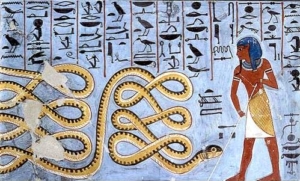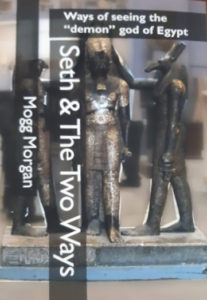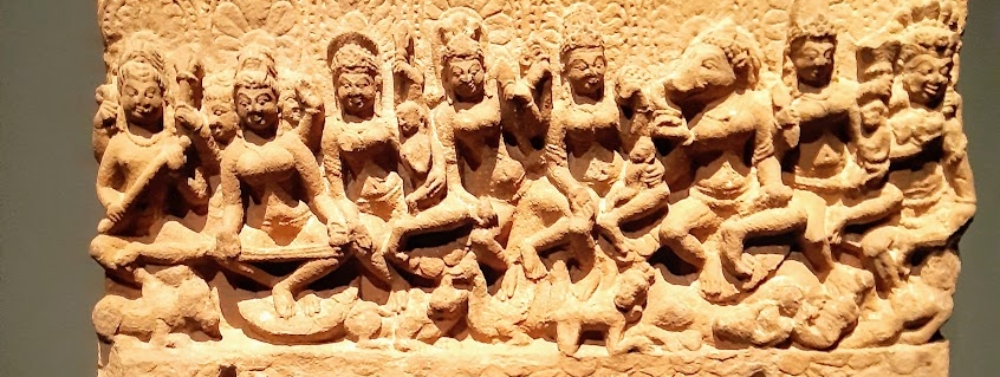
Part of my day job is reading and editing books, recently I was preparing the ebook edition of Seth & The Two Ways (Morgan 2019). Reading Appendix 2 – Book(s) of Overthrowing Apep (Bremner Rhind Papyrus 3), a papyrus found in Thebes (in Upper Egypt), probably from the tomb of a priest from the Ptolemaic period, filled with the most powerful and hostile of curses. To get the editing job done, I had to read the nine books in one go. Working on these texts I noticed a strange feeling creeping over me. As I read the first two books, I felt upset and unsettled, as if the disturbing words of the text caught me off guard and were now literally directed toward me. By the time I got to book three, the heavy feeling of despair changed to something else, difficult to describe. By books three and four, I could feel a surge of energy shooting up and down my spine and I could sense a powerful circle forming around me. When I started book five, The Book of Knowing The Creation Of Ra And Of Overthrowing Apep, I could almost see the circle of power enclosing me, on all sides. I felt protected and at the same time strong and ready, but for what?
By the time I finished reading book six, I had an insight into the nature of cursing and the importance of the god Seth in Egyptian Cosmology and its pantheons.
The ninth book vibrates the victorious rhythms of mission accomplished, the priest ferried through the most horrendous and atrocious curses, his spirit never failing, his heart never broken, his body fully charged with the primaeval power of the ancient serpent that vibrates with the secrets of creation. He is one with the Dark Lord, with the Red God, with the Black power of the North, he is ready to take on the ancient worm.
By the time I finished reading the ninth book, I felt powerful, strong, determined, and mighty. I was ready to slay a dragon.
Most of the curses and “grimoires” we are familiar with are working on a very specific psychological level – earthy and primal, to intimidate and bully a person, in the most extreme and influential ways, to make them believe they are cursed. As we know, this power is indisputable and when a person believes in something, it can be nearly impossible to argue with them or to change their minds.
This type of cursing is directed straight to the emotional centre, resonating with the lower and earthly vibrations to cause fear and upheaval in the lives of the ‘victim’. On the other hand, the person who does the cursing is as much trapped in the emotional realm of aggression and intimidation as the target is.
In order to curse an awesome and primaeval power such as Apep, the priest who conducted the ritual, needed to be as strong and as powerful as Apep, probably stronger.
I have come to believe that the Book(s) of Overthrowing Apep was meant to be read and performed as one ritual without a break. Like many other Egyptian texts, the Bremner Rhind Papyrus 3 is a text that takes us on a journey of becoming. The priest or priests build up their mental and physical resilience by vibrating those hostile words, channelling the power and assimilating them into themselves, transforming those nine books of curses into a powerful and mighty weapon of protection and strength.
I mentioned above how these texts were probably found in the tomb of a priest. They were included in the funeral rites and preparation for the underworld or night journey. Whichever way one looks at it, one can’t avoid the awareness that Apep is eternal, bornless and cannot be killed. This realisation could cause a psychological battle in the mind of the priest, leading to doubts, despair and resentment of his beliefs, and losing their ability to perform their roles properly in the temple. By turning the tables and learning the secrets powers of the curse, the priest acquires a tool of power, channelling the powers of the cursed one onto himself, freeing himself from the mundane state of existence, transforming and attuning his mind into the cosmic rhythm of the eternal.
Being equipped with such a papyrus, with such a powerful curse, in the tomb on your final journey, would be like the ultimate insurance policy against the immense forces of Apep the eternal, to protect his “soul” (Ba, Ka, Akh) on the final journey.
The Names Of Apep Which Shall Have No Existence – Book nine is like a repetitive mantra to be chanted and written on papyrus and to be burned in the fire. In the mantra, the name of Apep is repeated twenty-nine times! Each repetition is written with one of his terrible and horrific powerful characteristics, for instance – (21) Apep Kher Amam (Apep, The Fallen, The Devourer) (25) Apep Kher Kenemmti (Apep, The Fallen, The Dark One) (28) Apep Kher Sekhem-her (Apep, The Fallen, The Potent of Glance). Ostensibly it looks as if the priest is chanting and writing a very fierce curse. From my personal experience with mantra chantings, I can say that the more you repeat the same word, vowel or seed mantra, the more one can actually feel the energy gathering, charging and vibrating around and within you. You are becoming one with the rhythm, like the physical vessel of the mantra vibrations. The repetition of Apep’s name is the way in which the priest channels and charges the power into himself.
According to the instructions on the Abydos Temple walls, the daily temple ritual was performed three times a day. Based on information from Temple Ritual at Abydos by Rosalie David (2016), before entering the temple, the priests had to purify themselves in the water basins, the sacred lake or any other convenient pure water source. Weapons must be left outside the temple and only then can they approach the shrine door.
They open that door while saying: “I remove the finger of Seth from the Eye of Horus” step into the shrine and look at the God, saying whatever comes into their mind as a greeting. Perhaps something like this: “Be not unaware of me (Ra), If you know me, I will know you”. They
move into the shrine and stand before the altar and clean away any debris, tidy the place, lighted the fire and anointed all the deity’s statues and figurines with the daily perfume and made an offering of food etc saying: “Hetep di nesew asir neb djedu neter Aa neb Abdu” Which was the standard offering formula in Egyptian rites and can be adapted to any deity. Once all this was done, the priest positioned himself in front of the offering table and started to read the Book(s) of Overthrowing Apep, building up the energy to the triumphant crescendo of the chanting the words of book nine – The Names Of Apep Which Shall Have No Existence, finishing the rite by throwing the papyrus into the purifying flames of the temple fire.
One can almost see the rite taking place, almost feel the vibrations of the chants resonating within the temple. Now imagine how would it feels to visit that temple when the ritual of Overthrowing Apep has been performed a myriad times, since the Middle Kingdom when its existence was first recorded. For the uninitiated and the laymen, the temples in which this rite has been regularly performed must have been the most forbidding and eerie of places, haunted by wild-eyed priests. For the cult and its initiates, this was a place of power, a place to immerse yourself and to be charged with the endless baraka of the eternal one.
The Sethian myth is established on the sacred triad: Ra, Seth & Apophis, none could exist without the others. It is the battle-dance of creation, one dies, another must kill and one must shine.
The complete version of the Books of Overthrowing Apep (The Mother of all Curses) is reproduced in Mogg Morgan’s Seth & The Two Ways

Seth & The Two Ways
Ways of seeing the demon god of Egypt
Mogg Morgan
Format: Softcover/illustrated/many in colour.
ISBN: 9781906958831
£18/US$26
Subjects: Ancient Egypt/Egyptian Magick
Click HERE for Seth & The Two Ways / UK / £18
Click HERE for Seth & The Two Ways / USA and Worldwide / US$26

